
As soon as possible the settlers of Carroll County started to make arrangements for the preaching of the gospel and the education of their children. The building of the school was usually a structure made out of rough logs with one small window. This building would quite possibly serve a dual purpose for the community. One for their religious services and another as their schoolhouse.
The towns of New Hampshire, including Carroll County, did manage to keep
the philosophy of a "free" school. The school was intended for all the
children of, or belonging to the town. There was to be no restriction as
to age or attainments of the children, or the social condition of the
families to which they belonged. Girls as well as boys were to have the
benefit of the schools. This proves the fallacy of the statement, "that
for more than one hundred fifty years, girls were excluded from the
privileges of the schools in New England."
Following are a few of
the teachers that devoted their lives to educating the children of the
area.
SETH FLETCHER was hired as a teacher in 1654. (Strafford Co. at the
time) The date of his taking charge of the school, or the length of time
he taught, has not been ascertained. Indeed, the only evidence of his
having been the teacher is a receipt given by him, October 19, 1654, to
one of the tax-payers, for his school- rate "for the whole year." Mr.
Fletcher appears to have been a man of some importance. He was sometimes
employed as a surveyor and then afterward the first minister of Saco,
Me., being employed in 1666, for one year, and afterwards from year to
year, probably till 1675, when the town came near being destroyed by the
Indians.
In 1671 we can find JOHN STEPHENS being hired as a
teacher, of whom but very little is known. The salary paid this teacher
is not shown by the records, but whatever it may have been, it was
according to the vote of the town.
As time went on the teacher's
wages could be paid out of the money raised by taxation, and the rest
was to be assessed on the children attending the school. Under this
arrangement, the school was not strictly a free school. Not every town
did abide by this following but it did work for some.
Another
person employed as a teacher was THOMAS CROSBY, probably a son of Dr.
Anthony Crosby, of Rowley, Mass., whose widow, in 1673, married Rev.
Seaborn Cotton, pastor of the church.
SOLOMON PAGE, a native of
Hampton, was graduated at Harvard College in 1729, and afterward engaged
in teaching and in preaching. He was a resident here for several years
after his graduation, was the schoolmaster, and was employed for some
months to preach during the illness of the pastor, Rev. Mr. Gookin. [p.
384]
It does appears that many of these men were liberally
educated. In early times men only (as far as any records show) were
employed as teachers. It is quite possible, however, that women
sometimes taught the schools supported in addition to what the law
required. Since 1800, women have been employed more or less, and they
have formed a large percentage of our teachers.


This is a souvenir school photo
that belonged to my grandfather, Ernest Sargent.
The school was located near the
top of Godfrey Hill in Freedom but is no longer there.
Contributed by Linda Walls

This photo is one of all the pupils and the teacher of the High
Street School (now a private residence) taken around 1895 or 6 (I base this
dating on the fact that my grandfather, Albion Twombly, who appears as a boy of
about 7 or 8, was born on November 2, 1889). The back of the original photo has
a list of people in my grandfather's handwriting. I can only identify his sister
Annie Twombly, who is the second little girl from the left in the front row (in
the white pinafore); my grandfather Albion, who is standing immediately behind
the boy in the center of the first row; the little girl in the white pinafore
behind his right shoulder is his sister Jennie Twombly, who was Annie's twin
(which is why they are dressed alike; if you look closely you will see that
their pinafores and dresses are made of the same pattern and material); the
teacher, Binie (probably short for Albina I suspect, although that is just a
guess) Harmon is immediately behind Jennie. The older girl in the dark dress
behind Albion (not the one wearing a pinafore) is Lucy Twombly, the family's
oldest sister.
There are twenty-six people in the photo, but only
twenty-five names listed on the back. Also included in the photo are: Bertha
Kennett, Emma (or possibly Erma) Abbey, Lawrence or Laura (the ink is blotted)
Wirtson (might also be Wistrow), Irving Hobbs, Burt Banfield, Ida Jackson, Fred
Ward, Ivy McKirson (or possibly McKuron), Axie Chase, Herb Kennett, Marcia (or
Marcie) Chase, Frank Banfield, Nelson Towle, Mabel Ambrose, Ralph Kennett,
Myrtle Thurston, Frank Gray, Isodore Harmon, Erwin Gray, and Ruth Kennett.
Contributed by Tracy Bott

This photo taken at the Madison Elementary School circa 1925 or 6. In the back row, from left to right (starting with the boy with his arms crossed) is Burtwell Gary, Raymond Twombly (child of Albion and Eva Twombly, as are the other Twomblys in this photo), Alice Leavitt, Martin Prescott, Lillian Godfrey (the teacher), Earl Kennett, Marguerite Kennett, Woodrow Towle, Laura Twombly (she has a short, boyish haircut, but that IS Laura), Herbert Leavitt and Ruth Tyler (daughter of Arthur Tyler, Eva Twombly's older brother). In the second row (left to right, starting with the standing little girl with the black bow at her collar): is Janet Gerry, Barbara Twombly (seated), June Prescott, Jennie Twombly (named for her aunt shown in the 1895 or 6 school photo), Waldo Leavitt, Ellsworth Moore, Naomi Nason, Geraldine Towle, Geraldine Nickerson, Mary Leavitt, and Betty Towle. In the front row, (from left to right, starting with the first boy seated on the ground) is Gordon Towle, Wendell, Leavitt, Delmonte Moore, Robert Leavitt, Forrest Leavitt, Franklin Nason, Reed Gilman, Alfred Webster, Edgar Tyler, and Donald Kennett.
Contributed by Tracy Bott
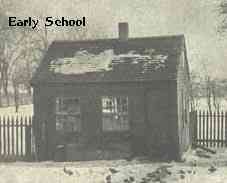 From the early beginning of the foundation of Sandwich the people realized
how important it was to educate their children. Soon after the area was settled
the first schoolhouse was built. By the early 1800's there were many small
schoolhouses in the rural areas of Sandwich, some were only a few miles apart.
By 1847 there were twenty-five schools, all single classroom buildings, each
served by one teacher. These school houses were usually one or two roomed and
were meant to be used to instruct the children through the sixth, or sometimes
the eighth grade. As time went on, the larger schools offered classes to
children up through the twelfth grade.
From the early beginning of the foundation of Sandwich the people realized
how important it was to educate their children. Soon after the area was settled
the first schoolhouse was built. By the early 1800's there were many small
schoolhouses in the rural areas of Sandwich, some were only a few miles apart.
By 1847 there were twenty-five schools, all single classroom buildings, each
served by one teacher. These school houses were usually one or two roomed and
were meant to be used to instruct the children through the sixth, or sometimes
the eighth grade. As time went on, the larger schools offered classes to
children up through the twelfth grade.
Bearcamp (Severance) School
Beede Academy
Birch Intervale School
Chick's Corner (True) School
Durgin (Folsom) School
Elthridge School, Fellows District
Fellows Ridge
Great Rock (Red Hill) School
Harrison School
Little's Pond School aka Potash School
Lower Corner (John Quincy Adams)
Mt Delight
North Sandwich (Quimby)
Quimby School - Center Sandwich
Sandwich Academy
Sandwich Notch Road
Stevenson Hill School
Union School
Vittum (East, Northeast)
Vittum-Hill Schoolhouse
Weed (Washington)
Whiteface School
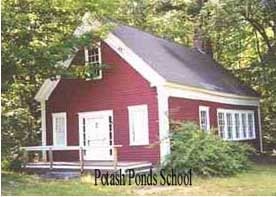
Teachers:
1857 Summer - Harriette A. Scarrett, finished by Antoinette Hoag
1857 Winter - Catherine Hoyt, Ellen Moulton, Addie Pease, Ida Quimby
1872 J. Emma Stevens & Mary White
1878 Mary N. Abbott & George Clark
1879 Angelia Smith & Amy Clark
1880 Ella Smith & Elizabeth Hodgdon
1881 Martha Corliss & John Hoag, Anna Clark
1882 Alma G. Hoyt 16 pupils
1883 Summer - Fannie A. Huntress 16 pupils
1883 Winter - Lizzie Watson 15 pupils
1884 Summer - Jennie Cartland 10 pupils
1884 Winter - Lizzie S. Severance 13 pupils
1887 Elmer Trasker 16 pupils
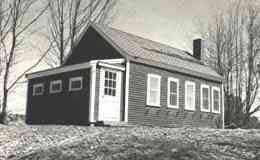 True was laid out in 1806 and seemed to have been named for one of the proprietors.
Rueben Moulton was the school director in 1811/12. Only two teachers are listed:
they are Charles Gilman in 1815 & Jacob Weed Page in 1816. Town reports of 1853,
'56 &'58 show 24-29 pupils were attending.
True was laid out in 1806 and seemed to have been named for one of the proprietors.
Rueben Moulton was the school director in 1811/12. Only two teachers are listed:
they are Charles Gilman in 1815 & Jacob Weed Page in 1816. Town reports of 1853,
'56 &'58 show 24-29 pupils were attending.
When the division line was settled, True and Etheridge's districts had the same directors and teachers.
Although, the accounts of the districts were kept separate. In 1839 the names of the districts were
changed to numbers, and thus No.5 and No.6 were now the known names of these two school.
Following is a list of the teachers they shared.
1807-09 Eunice Rogers 4 months both districts $18.67 Pd.
1808-09 Sewall Wolcott & Hannah Horne
1810 John Beede school director, Rachel McGaffey & Eunice Rogers
1811 Reuben Moulton
1811-1820 Jacob Beede
1813 Jacob Weed Page
1817 Josiah Marston
1853 Mary E. Gilman
1856 Alvan G. White
1858 Lydia Dearborn summer school
1858 Jacob Taylor until school closed due to lacking pupils
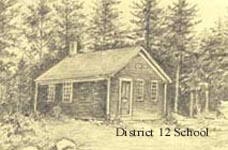 This 18'x24' school was built in 1825 at a cost of $130. School Committee:
Jeremiah Smith (director), Benjamin Way, Sam Smith, & Ezra Meader.
Record books kept 1824-1877.
This 18'x24' school was built in 1825 at a cost of $130. School Committee:
Jeremiah Smith (director), Benjamin Way, Sam Smith, & Ezra Meader.
Record books kept 1824-1877.
Teaching Staff:
1824 Sarah Beede
1827 Mehitable Beede
1829 Laura Kimball
1830 Daniel G. Beede
1830 Thomas Beede Weeks
1840 Naomi Beede
1845 John Beede, Jr.
1853 Lydia A. Dearborn
1853 Lydia Weed
1854 Emily Hoag
1854 Daniel Weeks
1866 Addie Pease (Mrs. Sylvester Brown)
1867 Addie Pease
1868 Eliza Jane Smith
1870 Mary C. Davis
1870 Elsie Jane Smith
1870 Edwin M. Marston
1871 Elsie E. Locke
1871 Albion Marston
1871 Georgiella Smith
1872 Orra A. Locke
1873 Ada F. Locke
1873 Mary E. Tanner
1874 Clara P. Moulton
1874 I. Della Folsom
1884 Julia E. Locke
1884 Jennue M. Cartland
1888 Ella F. Weeks
1888 Carl G. Beede
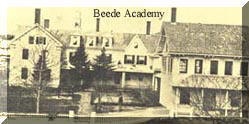 School building and home of Daniel G. Beede
School building and home of Daniel G. Beede
Few families have played a larger role in the history of Sandwich than the Beedes. One of the well known Beede men that has contributed so much to Sandwich and its history was Daniel. Daniel Beede established the Beede Normal Institute in Center Sandwich, and it was known as one of the best training schools for teachers in the State. The school was established in 1839. It did develop a reputation for preparing. Few families have played a larger role in the history of Sandwich than the Beedes very qualified teachers. All the buildings for this Institute were built at Mr. Beede's expense. The school also had never been endowed. Daniel Beede was its head for more than thirty years and never received any financial aid from friends or State. Students attended this Institute in the hundreds. Some of the students were:
Celia N. Ambrose
Carrie M. Atwood
Frank J. Atwood
Harry A. Atwood
Anna E. Beede
Carl G. Beede
D. Edward Beede
Lillie M. Beede
Ella C. Blanchard
George A. Blanchard
Thomas Burleigh
Lizzie M. Caverly
Amy M. Clark
Lulu Clark
Mattie B. Calley
Fannie S. Fellows
Melvin A. Fogg
Frank C. Folsum
George E. Hanson
Elmer B. Harte
Arthur M. Heard
Walter D. Hill
Asa J. Horne
Carrie L. Hoag
Hattie E. Horne
Annie O. Mack
Herbert H. Mack
Warren J. Moulton
Leonard Mudgett
Mary E. Pierce
Sarah P. Quimby
Samuel B. Smith
Grace Stanton
Annie M. Tappan
Charles L. Wallace
Emma L. Wallace
Eugene Wallace
Laura J. Wallace
Frank J. Webster
Carrie E. Willey
[More information about this school can be found in "The Statistics & Gazetteer of New Hampshire" 1874 by Alonzo J. Fogg.]
In 1875 George Dorr opened a High School in Center Sandwich. This school did not continue long as Mr. Dorr felt the need to leave and study for the ministry. While the school was in session it was ten weeks long, the Spring term ending in time for the students to help on the farm. The tuition cost, subjects offered etc. may be seen at the Sandwich Historical Society House.
James A. Smith was one of the famous singing school teachers. Mr. Smith had a love for music that he wanted to teach to others. Not only did Mr. Smith sing he was also considered a very talented musician. The admission to this school was by a card. The exact way the card was used is not known, but it is assumed that possibly the student had been tested in some way or else a fee could have been charged. This school was held in the upper floor of the Smith Tin Shop, in the Beede School House. Source: Sandwich Historical Excursion
The chance to get a higher education in the first half of the century were rare. It was usually provided by small academies sponsored by leading citizens. Sandwich was lucky enough to have one on Wentworth Hill from 1837-1949. Some of the students who attended were
Mary Ambrose
Samuel Ambrose
Maria Batchelor
David S. Bean
B.F. Beede
James M. Beede
James R. Bradbury
John Butler
Wm. H. Chandler
Daniel L. Choate
Asa Clark
Langdon G. Clark
Charles H. Dow
H. D. Eastman
Josiah Fogg
Eliza G. French
Ezekiel French
Norman French
Edmund Frost
Daniel Furber
Alfred Goss
Oliver Goss
Josiah M. Haines
Samuel Haley
H.G. Hanson
Lydia S. Hayes
Amos A. Hill
Maria Hoag
Daniel Hoyt
Aaron Hyde
Moses Hyde
Thomas D. Jewett
Sarah Leach
Alfred Mason
James Mason
Wm. McCrillis
Elden McGaffey
Irene McGaffey
Ann G. Moulton
John B. Norris
Sarah Norris
Mary J. Pratt
Augusta M. Quimby
Lucy Quimby
Sarah A. Quimby
Susan Quimby
Sarah S. Scarlett
Moses Scribner
James S. Severance
Ann E. Shannon
Nathaniel Shannon
Eliz. W. Stevenson
Nelson Vittum
Moses V. Wallis
John Wedgwood
G.W. Wentworth
Teachers of Sandwich Academy were: John R. Varney held a Professorship in Dartmouth College. Joseph McGaffey was a graduate of Dartmouth College and an accomplished scholar. Aaron B. Hoyt was the last Preceptors of Sandwich Academy; a man of great knowledge, far beyond the average college graduate. Samuel French, James Osgood, Edward H. Greely, John Riley, Wm. A. Kimball, Joseph McGaffey, and Aaron Beede Hoyt.
Expenses: The tuition was $3.00; instruction in Languages, $4.00. Board was usually with good families
in the village at a cost of 8-10 shillings per week. Students could also make arrangments to board
themselves with good rooms at a moderate charge.
School Term/Vacation: School had four terms divided into 11 weeks each. The first week starts on the first Wed. in December;
the second on the first Wed. in March; the third on the first Wed. in June; the fourth on the first Wed. in Sept.
There was a vacation of two weeks at the end of each term.
There was a second Academy and this one was directed by Rev. Albert Ethridge, in 1829. He was the son of Samuel & Lydia (Cook) Etheridge. The Academy was in a building that later became known as Grand Army Hall. Students were: Ann T. Burleigh, Sarah L. Sherman, Susan Ann Sherman, Mary Abbie Smith and Charles H. White
Teaching Staff:
1856 Anna F. Hoag and Mary A. Perkins
1857 Sarah E. Dearborn, Abby S.M. Bennett, and Walter E. Bryant
1858-1880 Amy Hoag, Eliza Dearborn, Cavanaugh Hill, Eliz Sweatt, Wilbur Sanborn, Alonza Kimball,
George Varney, Eliz Hoyt (Slager), Anna Clark (Wiggin), Justin Mason, Herman H. Quimby, Lydia Wentworth
1880 Nellie L. Brown (Clark)
1882 Lulu M. Clark and Annie E. Watson
1883 Martha E. Vittum
1884 Frances A. Perkins
1886 Clara V. Jacklard and Lizzie S. Severance
1889 Bertha Vittum and C. E. Corliss
1890 Mabel Quimby
1891 Bertha Vittum and Lizzie B. French
1892 Lizzie B. French and Lizzie B. Graves
1893-4 Lizzie B. French
1895 Alice M. Blanchard (Morehouse)
1897 Urban Wallace and Edgar S. Goss
1898 A.B. Hoag and LuLu Knight
1899 A.B. Hoag and Isabel Forbush
1900 Isabel Forbush
Very early on the town made provisions for at least limited education. It is interesting to note the monies that the "charter of grantees" allotted in 1776 it was £8, only one half to be paid out in the winter, and the other half in the summer. By the year 1782 monies considered sufficient to support a "man school" for six months was £60.
1776
– William Blaisdell (appears he occupied this position for 25 years)
1791-1793 – Master Nicolson pd-12 shillings, Master
Robinson pd-£2 , Colonel J. Wingate pd-£3, Master John Blasdell, David
Glody, Isaac Fellows, Capt. Andrew Gilman, Walter Neal, Joseph Gage,
Abner Allen, Master Evans
1794 – Daniel Hall, John Dame, Mr.
Newlson
1807 – Elizabeth Piper
1808 – Richard F. Dow,
Sally Copp, Samuel Fellow
1796-1805 – The first schools were in private homes, but in the fall of
1796 a schoolhouse was built.
1796 – Wiggin District
1798 – Piper, Lower District, Oak Hill, Wingate (corner), Fellows,
Dow, Horn, Clark, Pine River, Wentworth
1805 – An act of
legislature authorized the town to divide into school districts. Before
this was done by arrangement of the inhabitants or selectmen. In 1827
the former town system gave place to the district system.
1882 –
Twelve school districts
Many of the fathers were college learned, and the first minister and
other leading men took great interest in education. In some towns the
parish minister was the only educated man. Not so in Wakefield. College
graduates this town had right along. Dartmouth, Harvard, and Yale are
some of the schools familiar to former young Wakefield students.
1817 – Dow Academy
1827 – Wakefield Academy
1886 – Brewster Free Academy. John Brewster attended the Wolfeboro
and Tuftonboro Academy in 1818. Some sixty years later, under his will,
the Academy charter was amended and the name was changed to Brewster
Free Academy, to provide a free high school education to local
students.
He left $500,000 to the school and his support was to
continue as long as the property remained tax exempt. It included a
sizeable tract between South Main Street and the lake front. John
Brewster's Will also stipulated that the school must be non-sectarian
and students must attend daily devotions and "divine services on
Sunday." "Formation of character" was to be the aim of the school.
The first Brewster Free Academy building was erected on a beautiful
site between South Main Street and Wolfeboro Bay, at a cost of $150,000.
This burned in 1903 and the present building opened in 1905. When
Kingswood Regional High School opened in 1964, B.F.A. became Brewster
Academy, an important private school, which receives some support under
John Brewster's Will.
1785 – Nathaniel Ambrose, Jr.
1791 – Samuel Tucker, Abraham Peavey,
George Nicholson
1793 – Anna Blake
1794 – Thomas Demerritt,
Colonel Mark Wiggin, William Kent, Betsey Wiggin
1796 – Moses
Thompson
1797 – Katherine Edmonds, Horatio G. Balch, Moses Bickford,
Nancy Wiggin
1798 – Benjamin Canney
1799 – George Melville, John
French, Joseph Odiorne
1800 – Samuel Fox
1801 – Israel Piper,
Betsey Lucas, Betsey Fernald
1802 – Nancy Coleman, Charles Barker,
Jonathan Copp
1803 – Samuel Wiggin, Betsey Gould, Sarah Johnson,
James F. Moulton, Mrs. John Snell, Mrs. Josiah Frost
1804 – Weathan
Wiggin, Hiram Hodge
1805 – Aaron Boodey, Nehemiah Ordway, Henry
Horne, Ebenezer Meader Jr.,
1806 – Stephen L. Creighton, Polly Gould,
Charles Foss, John Brown
1807 – Dudley Leavitt "the almanac maker",
Miss Savage, Sanborn Blake, Thomas Stevenson, Jane Stuart
1808 – John
Bassett, Moses Connor, Isaiah G. Orne, Hannah Lucas
1809 – Nathaniel
Burleigh, David T. Livy, John J. Coleman, Jonathan Blake, John Rines,
Hannah Horne, Mary Young, Charles Foss, Abigail Meserve, Polly Gow
1811 – Joseph Farrar, Joseph Shorey, William Cotton, Daniel Fellows
1812 – John W. Horne, John C. Young, Joseph Edgerly, Thomas J. Tebbetts,
Dearborn Wedgewood, Mary Hayes, Sally Crosby, Dolly Tebbetts, Betsey
Brewster,
1813 – Samuel Bureligh, Olive Shepherd, Jonathan Bickford
Jr., Nancy Philbrick, Elizabeth Powers, George W. Warren
1814 – Mary
Copp, Samuel Leavitt Jr., Gideon Straw, George Nowell, Sarah Lyford,
Deborah Gilman
1815 – David B. Straw, Henry Tebbetts, Abigail Snell
1816 – Hannah Gage, Mary Dudley
1817 – Charles Gilman, Polly Hawkins
1819 – David Fullerton
1820 – Betsy Lucas
It appears from the town records that in 1793 the first schoolhouse was
erected and it was located near the Daniel Brewster farm.
1820 –
School districts had increased to 12, above the Bridge, below the
Bridge, Furbur, Pine Hill, Center, Haines, Farm, Young, Jenness, Pierce
Doe, Tebbett's
1823 – Wolfeborough & Tuftonborough Academy Incorp.
1866,
approx. – Christian Institute
1886 – Brewster Free Academy
Copyright © 1996 - The USGenWeb® Project, NHGenWeb, Carroll County